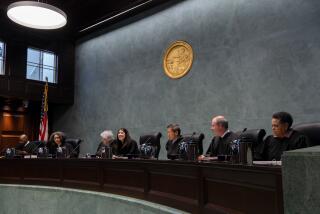Ready for a Change
The annual California Taxpayersâ Assn. conference in Sacramento this past week was called to discuss, naturally, taxes. But the sessions demonstrated that it is impossible to talk about taxes without confronting a distressing array of problems facing California, many of them stemming from a veritable breakdown in the basic structure of government in California.
There were few optimistic comments from the speakers, including legislators, lobbyists and even a social historian. One said that California in 1989 is having to cope with âa disproportionate number of stupid chickens coming home to roost.â Another: âThis is the year we get terribly close to paralysis.â
But there also were some rather surprising proposals from surprising sources, indicating that most California leaders are ready for some basic change in how the state is governed and taxed. The business-oriented taxpayers association itself is sponsoring a proposed constitutional amendment that would significantly relax the Gann limits on state and local spending. A building industry official said his organization would support a return to the pre-Proposition 13 concept of increasing taxes by a majority vote.
Some participants even suggested a state constitutional convention to get California out of the box it has been put in by an increasing number of budget and tax restrictions such as Proposition 13, the Gann limits and Proposition 98, the initiative passed last November that guarantees schools about 40% of the state budget each year. The convention suggestion drew some audible gasps, but also considerable nodding of heads.
The box has been constructed by a variety of pressure groups that have skirted the Legislature and used the initiative petition process to carve out special benefits for themselves. The result is not enough revenue to handle ongoing governmental operations, let alone those capital projects needed to build for the future.
In the past, Californians worked collectively toward a bright future of universities, freeway s and water projects. There is considerable nostalgia now for those days, but historian Kevin Starr said there can be no return to the past. The problems are radically different, money is not available and the people distrust grand projects and giant bureaucracies. The future lies with more creative, productive government, Starr said. He is correct. While more money is needed to build more freeways now, California never can solve its transportation dilemma merely by building ever-more roads, or even transit systems.
The jury-built tax system drives many of Californiaâs problems. For instance, local government, desperate for new money, now encourages development to gain revenues through the sales tax. But a big new mall on the edge of one city creates a whole set of problems for its neighbors, too. There is growing sentiment for some form of sharing of the new revenues, as well as the problems, entailing coordination of planning at the local, regional and state levels.
The immediate outlook is for some half measures that may, at best, alleviate some of the worst problems. But the Legislature and governor, working with business and public-interest groups, must do much more. They must re-examine basic programs and traditional solutions, and untangle the unintended consequences of past mistakes. To do so, the Legislature must get its own houses in order and exercise some strong leadership.
But most analysts of the gridlock in Sacramento say the greater problem is with the governorâs office. George Deukmejian must be convinced that the last 22 months of his governorship provides the opportunity to launch an exciting new cooperative society that is worthy of the worldâs sixth-largest economic power. Many believe that cannot be done until the state has a new, more visionary governor. But the future will not wait.
More to Read
Get the L.A. Times Politics newsletter
Deeply reported insights into legislation, politics and policy from Sacramento, Washington and beyond. In your inbox three times per week.
You may occasionally receive promotional content from the Los Angeles Times.










